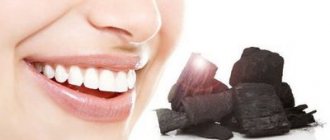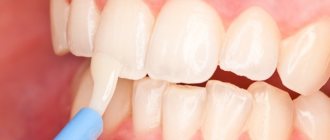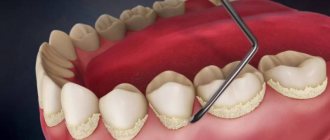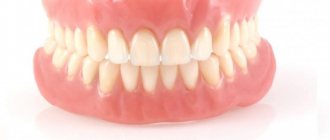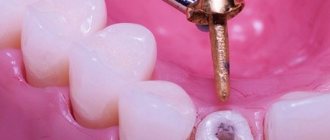A tooth has broken off and is cutting my tongue. Can I sharpen it with a nail file at home?
When there is a lot of stupidity, you can do anything.
They used a file to file their nails; it was unlikely that it was processed after each use. There are all sorts of microbushes there. And we are thinking of putting this nail file into our mouths. But even if the file is clean, is it worth putting it in your mouth? No dentist will recommend filing chipped teeth at home with nail files. Even if its edges cut your tongue or cheek. The doctor will say that this is unhygienic, dangerous, pointless. And that by filing your teeth, you can turn things around in such a way that there will be even more pain. Damage the enamel, grind down the wrong surface, after which it will be impossible to eat or sleep at all.
But anyone who has had their teeth chipped knows how unpleasant it can be. The tongue or cheeks can be cut so that a real wound is formed. And no painkillers will help. The tooth itself may not hurt, but the mucous membranes around it may be seriously injured.
I agree with people who will say that in the most urgent cases you can try. When there is no one to go to and it is no longer possible to endure. But don't do it as decisively as you want. Process the tool.
If it is difficult to stop a person, the pain is so strong and the determination to file the disturbing tooth on your own drowns out the voice of reason, even use your filing tool.
Wash the file thoroughly with alcohol or at least hot water and soap. Rinse multiple times, not just once. And only after this procedure, start cutting off the sharp pin. If you feel that the file is touching a nerve, you will have to complete this manipulation and go “confessingly” to a good dentist.
If a tooth breaks off. The best recommendation is to see a dentist. The fact is that you are unlikely to be able to determine on your own the severity of the damage. Possible infection can lead to unpleasant consequences and the result will be that “the miser pays twice.”
Treating a tooth yourself is not a good idea. Especially sharpen it with a nail file. Now it is unknown what the nail files are made of. And if you examine a nail file under a microscope, you can see a lot of harmful things. And the file is intended primarily for hands and feet.
So sharpening a tooth with a file is not a good idea. You can introduce some kind of infection into your mouth and it will only get worse. Either the lips will swell, or the herpes will pop out. So the best decision if a tooth chips is to wait until the morning and go to the dentist. He will do everything quickly and reliably
Although, if your tongue really cuts the tooth, take a file and carefully sharpen it. The main thing is not to let the nail file touch your tongue and lips. If, however, you have the patience to endure and still go to the dentist, I wish you good doctors as in the photo below. The main thing is positive, and then pain)
Theoretically, it is very possible to sharpen a chipped tooth. That is, you can round the sharp edge, make it less cutting, and save yourself from the suffering that can be caused by constant mechanical friction of the fragment against the tongue.
It is absolutely clear that this method is not professional, not sterile, not a panacea, and generally not acceptable. But if we don’t academicize the situation and assume that if we don’t take independent emergency measures (being, for example, in a dense forest with a nail file in our hands and without a dentist in our pocket), we can lose a healthy tongue in a few days or a normal psyche from pain, then Of the two emerging evils, you need to choose the lesser. And then, armed with a file treated with alcohol, intuition and a mirror, you can make several movements on the tooth. May I help. And they don’t do such manipulations when there is no other way out.
No, you shouldn’t do this, when my tooth chipped, I went to the dentist, fearing that he might put a filling or something, but he just palpated it for me, now it doesn’t cut and it doesn’t hurt to drink cold/hot water, you shouldn’t do it with a file it can be dangerous, you may get to the nerve, make it worse, go to the dentist (my advice to you).
Can. There is absolutely nothing wrong with this. Otherwise you will continue to suffer. File off the sharpest edge (just use a file several times, it’s easy), the dentist will do the rest when you get to him.
Theoretically, it is possible - the tooth is not an appendix, although people even cut it out for themselves, being far from civilization - at the North Pole - there are no surgeons there, there are no clinics. There was no way out - the man cut it out for himself. And everything went well.
But with a tooth - it seems possible, but suddenly an open nerve forms there - the tip is not cut off, but another piece of the tooth breaks off. Or an already open nerve, then you can run into terrible pain!
On the other hand, the file must be impeccably sterile so that, God forbid, it does not cause an infection!
You can very carefully try to see what it feels like, is there any pain, sharpen the tooth and everything will be fine! But the main thing is not to get infected!
I can tell you from my stupidest experience: once a tooth fell off, I didn’t go to the dentist, the tooth crumbled and began to hurt terribly. I was sick because of the root. And there was such a desire to take something thin and sharp, climb into the cavity and at least clean everything there a little. I know - this is very stupid, especially - not the Far North - there is an avalanche around dentists - you pay money - they will politely and carefully solve the problem with your tooth! There are pharmacies nearby - if the pain is severe, there are plenty of painkillers.
Is it possible to straighten teeth without braces?
The best treatment is to prevent this situation from happening. In common parlance, this is prevention and prevention . Prevention is possible in children at an early age; parents must detect problems. If parents make every effort at an early age, they will spend a minimum of money and time in the future. Prevention is much cheaper than treatment.
Prevention includes:
- Proper cleaning.
- Using the correct brush.
- Using an irrigator.
- Daily care routine.
- Removing tartar.
- Strengthening enamel.
If there is already a defect, dentists advise wearing braces. It would seem that what’s wrong, put it on and wear it. But no. It's far from simple. Therefore, not every person wants to put braces on their teeth. In addition, before the procedure for installing braces, you will need to idealize the condition of the oral cavity. Firstly, caries is treated. Secondly, they carry out a complete cleaning and disinfection of the oral cavity.
Who is indicated and contraindicated
Teeth grinding is a dental procedure that is aimed at correcting visible defects: uneven edges, enamel damage, and malocclusion. In addition, it is used during operations, using it as a preparatory stage.
Photos before and after teeth filing:
Before going for dental filing, consultation with a specialist is required. Whether it is possible to file the front teeth depends on the presence of contraindications, which include:
- bruxism (teeth grinding during sleep, occurs regularly at night);
- increased sensitivity of enamel;
- accelerated destruction of tooth enamel;
- the patient's exposure to bad habits (gnawing nuts with his mouth, nibbling the ends of pens and pencils);
- increased risk of injury to incisors or canines (especially in boxers and wrestlers).
If the specialist did everything correctly, the teeth will be filed without difficulty. There can be only one nuance - the enhanced sensuality of the enamel. But it lasts for a few days and then goes away. The existing correction options are calculated by the doctor you contacted. Dental grinding is necessary when other correction options, in the opinion of a specialist, will not help.
How to quickly straighten teeth: methods
- Veneers. Veneers are lightweight, discreet and invisible plates that are attached to the teeth. They are made from porcelain. Veneers are used to correct minor teeth imperfections: cracks, chips, etc.
Veneers do not move teeth, they only mask minor imperfections. They have a very impressive service life due to their resistance to chemical influences. The cost of such adjustments is insignificant, and additional regular visits to the dentist are not required.
- Mouthguards. Mouthguards are transparent caps that are placed on the teeth. Mouthguards are made from plastic. Mouthguards correct only minor imperfections.
The cost of mouth guards is higher compared to other methods. But it should be noted that they are very comfortable and look nice on the teeth.
- Trainers. Trainers are a special device for straightening teeth in children. Such a jaw object will help change the dentition and teach the jaw to function correctly, and also tones the muscles of the face and tongue. In this case, it is an ideal assistant for parents so that their children have straight and beautiful teeth. They are usually used by children aged 6 to 12 years. In addition, if you use the trainer in childhood, you will no longer need the services of an orthodontist in the future. This is due to the fact that the trainer does not eliminate the bite itself, but the cause of its occurrence.
Children's trainers are enough to be worn by a child at night. This is enough. It is also recommended to consult with a specialist . The specialist will advise you on how to use the trainer correctly or, conversely, find any contraindications.
The best way to correct dental imperfections and make your smile more attractive is veneers. To prevent malocclusion and correct the cause itself, the use of children's trainers is recommended. A children's trainer is the fastest and safest way to straighten teeth.
Technique
The operation of cutting down teeth to straighten them takes place in several steps:
- Preliminary preparation: the dentist assesses the dental condition. Then determines whether there is a need to file hard tissue. At the end, a conclusion is made about whether the patient has contraindications to the operation.
- Finding areas that have problem areas. To do this, a carbon copy, liquid spray or wax strip is taken, and the dentist identifies irregularities and abnormal heights of some teeth. Those areas that need filing are stained more heavily.
- Anesthesia and filing. The process is carried out differently in each case. Each patient has an individual dental arrangement. This is also due to the fact that there are various goals that need to be achieved. Also important is the individual shape of the teeth, which need to be ground down to straighten them.
For example, processing chewing molars. The dentist carefully files down the top layer of enamel from the surface of the tubercles. To file the central incisors, the doctor uses cutting movements in various directions.
There are cases when it is necessary to make a preventive model for diagnosis, which is based on casts of the jaws. The samples received by the dentist are thoroughly reviewed and filing options are assessed. The standard tools in the operation are carborundum cutters or diamond burs.
How is the procedure carried out?
The methods and place of influence themselves will differ from the purpose for which the filing is performed. It usually goes through the following stages:
- Preparation - the doctor examines the condition of the patient’s oral cavity, determines the presence of defects, and determines treatment methods and contraindications. If necessary, can carry out professional cleaning of surfaces before manipulation.
- They determine the area of influence - with special devices (copy paper, aerosol, wax plates) they mark the areas in which cutting is required. To do this, for example, they paint the area of high teeth (if their level is uneven) in a different color, so that in the process they do not make a mistake with the amount of sawed tissue.
- Direct preparation - depending on the purpose, the methods of treating the tooth will differ. So, if the chewing unit is ground down, then the upper tubercles are affected. And when processing incisors, multidirectional movements are needed.
The final stage is always the polishing of surfaces and the procedure for remineralization of teeth. Thus, the edges of the enamel are made smooth and snow-white. And replenishing the structure of hard tissues with useful substances helps to strengthen them and protect them from any aggressive external influences. As a result, the tooth will remain healthy and intact even after such a procedure.
Possible complications
If we talk about complications of tooth sharpening, then, first of all, it is a reaction expressed in increased sensitivity of the enamel after surgery. This usually goes away within a week. If the sensitivity does not go away, you should contact the dentist who did the filing. As a rule, no more complications arise if the operation was performed by a qualified specialist and not by an amateur.
Increased sensitivity is the effect of dentin, which is located under the enamel. It passes through many channels. They contain nerve endings. When the thickness of the enamel layer decreases, the pressure changes, resulting in pain from hot or cold drinks and foods. During adaptation, dentists advise not to eat solid foods, very cold or hot foods, or highly acidic drinks.
Reviews
They filed down my tooth for a crown. Even with pain relief, I felt discomfort. This is a rather unpleasant procedure. But the main thing is that after this the product is installed efficiently, otherwise the exposed tooth will quickly collapse.
When I decided to get veneers, I understood that I would have to cut off part of the surface. But I don’t regret it at all, because my smile has become perfect. The most important thing in this is choosing a good specialist so that he does not damage your enamel.
After this treatment, I suffered from tooth sensitivity for a long time. I used pastes, rinses, etc. The doctor said that this was a normal reaction, since the nerve endings were left without protection. I hope that after the crown is installed, these sensations will go away.
Home filing
Some people wonder if it is possible to sharpen their front teeth at home and how to do it.
If there is fear of doctors and the operation itself, and there are thoughts about the unprofessionalism of specialists, patients try to file their teeth themselves.
Experts, without any reservations, forbid even trying to do the filing yourself. The patient will not be able to determine the condition of the oral cavity and the necessary actions to be taken. Only a professional dentist can perform a high-quality operation. This is a guarantee of quality and absence of complications.
If you need to file your teeth, the price will depend on what exactly needs to be done.
Who is indicated and contraindicated
Teeth grinding is a dental procedure that is aimed at correcting visible defects: uneven edges, enamel damage, and malocclusion. In addition, it is used during operations, using it as a preparatory stage.
Photos before and after teeth filing:
Before going for dental filing, consultation with a specialist is required. Whether it is possible to file the front teeth depends on the presence of contraindications, which include:
- bruxism (teeth grinding during sleep, occurs regularly at night);
- increased sensitivity of enamel;
- accelerated destruction of tooth enamel;
- the patient's exposure to bad habits (gnawing nuts with his mouth, nibbling the ends of pens and pencils);
- increased risk of injury to incisors or canines (especially in boxers and wrestlers).
Contraindications
Despite the fact that filing is a preparatory step for other types of dental procedures or helps eliminate dental defects, the procedure still has a number of contraindications:
- Increased rate of tooth enamel abrasion
- Grinding of teeth while sleeping or chewing food
- Increased tooth sensitivity
- Bad habits such as chewing seeds, opening bottles with teeth
- High risk of dental injury as a result of martial arts training
Technique
The operation of cutting down teeth to straighten them takes place in several steps:
- Preliminary preparation: the dentist assesses the dental condition. Then determines whether there is a need to file hard tissue. At the end, a conclusion is made about whether the patient has contraindications to the operation.
- Finding areas that have problem areas. To do this, a carbon copy, liquid spray or wax strip is taken, and the dentist identifies irregularities and abnormal heights of some teeth. Those areas that need filing are stained more heavily.
- Anesthesia and filing. The process is carried out differently in each case. Each patient has an individual dental arrangement. This is also due to the fact that there are various goals that need to be achieved. Also important is the individual shape of the teeth, which need to be ground down to straighten them.
For example, processing chewing molars. The dentist carefully files down the top layer of enamel from the surface of the tubercles. To file the central incisors, the doctor uses cutting movements in various directions.
There are cases when it is necessary to make a preventive model for diagnosis, which is based on casts of the jaws. The samples received by the dentist are thoroughly reviewed and filing options are assessed. The standard tools in the operation are carborundum cutters or diamond burs.
How is the procedure carried out?
The technique of filing teeth consists of several stages:
- Preparation. At the first visit, the dentist assesses the condition of the dentition, decides whether there is a need for the procedure, whether it is necessary to file down hard tissues, and questions the patient about the presence of contraindications.
- Identifying problem areas. To do this, the dentist uses carbon paper, a liquid aerosol or a wax plate. These tools help pinpoint high spots on teeth. Areas that will be more intensely colored will need to be filed down.
- Direct cutting. Depending on the purpose of filing and the shape of the problem tooth, the procedure may differ slightly. So, to grind molars, the dentist carefully cuts down the top layer of enamel from the surface of the tooth. If it is necessary to cut down a significant amount of hard tissue, the operation is performed under anesthesia.
If necessary, the filing operation is performed under local anesthesia.
In some cases, it is necessary to make an impression of the jaw row before the procedure. The resulting material is assessed by the dentist, and areas that require filing are determined.
After the procedure, the treated teeth are polished and remineralized. The doctor applies a composition on them in the form of a complex of useful substances to reduce permeability and increase the strength of the surface layer of the tooth.
Possible complications
If we talk about complications of tooth sharpening, then, first of all, it is a reaction expressed in increased sensitivity of the enamel after surgery. This usually goes away within a week. If the sensitivity does not go away, you should contact the dentist who did the filing. As a rule, no more complications arise if the operation was performed by a qualified specialist and not by an amateur.
Increased sensitivity is the effect of dentin, which is located under the enamel. It passes through many channels. They contain nerve endings. When the thickness of the enamel layer decreases, the pressure changes, resulting in pain from hot or cold drinks and foods. During adaptation, dentists advise not to eat solid foods, very cold or hot foods, or highly acidic drinks.
Increased sensitivity after the procedure
Many patients who have had their teeth filed complain of increased sensitivity, especially when eating hot and cold dishes and hard foods.
Dentists explain this phenomenon as follows. Dentin, located under the enamel, is penetrated by many tubules, inside of which nerve endings are located. As the thickness of the enamel decreases, pressure changes occur, which can cause pain when taking certain foods.
To reduce tooth sensitivity after the procedure, dentists recommend temporarily avoiding too hard foods, dishes with high and low temperatures, and acidic drinks.
During oral hygiene, you should use a brush with soft bristles and therapeutic and prophylactic toothpaste, rinses for sensitive teeth.
If sensitivity does not disappear a week after filing, you should contact your dentist.
Indications and contraindications for orthognathic surgery, recovery time.
In this article we will tell you how to install braces on crowns.
Home filing
Some people wonder if it is possible to sharpen their front teeth at home and how to do it.
If there is fear of doctors and the operation itself, and there are thoughts about the unprofessionalism of specialists, patients try to file their teeth themselves.
Experts, without any reservations, forbid even trying to do the filing yourself. The patient will not be able to determine the condition of the oral cavity and the necessary actions to be taken. Only a professional dentist can perform a high-quality operation. This is a guarantee of quality and absence of complications.
If you need to file your teeth, the price will depend on what exactly needs to be done.
Who is indicated and contraindicated
Teeth grinding is a dental procedure that is aimed at correcting visible defects: uneven edges, enamel damage, and malocclusion. In addition, it is used during operations, using it as a preparatory stage.
Photos before and after teeth filing:
Before going for dental filing, consultation with a specialist is required. Whether it is possible to file the front teeth depends on the presence of contraindications, which include:
- bruxism (teeth grinding during sleep, occurs regularly at night);
- increased sensitivity of enamel;
- accelerated destruction of tooth enamel;
- the patient's exposure to bad habits (gnawing nuts with his mouth, nibbling the ends of pens and pencils);
- increased risk of injury to incisors or canines (especially in boxers and wrestlers).
If the specialist did everything correctly, the teeth will be filed without difficulty. There can be only one nuance - the enhanced sensuality of the enamel. But it lasts for a few days and then goes away. The existing correction options are calculated by the doctor you contacted. Dental grinding is necessary when other correction options, in the opinion of a specialist, will not help.
Technique
The operation of cutting down teeth to straighten them takes place in several steps:
- Preliminary preparation: the dentist assesses the dental condition. Then determines whether there is a need to file hard tissue. At the end, a conclusion is made about whether the patient has contraindications to the operation.
- Finding areas that have problem areas. To do this, a carbon copy, liquid spray or wax strip is taken, and the dentist identifies irregularities and abnormal heights of some teeth. Those areas that need filing are stained more heavily.
- Anesthesia and filing. The process is carried out differently in each case. Each patient has an individual dental arrangement. This is also due to the fact that there are various goals that need to be achieved. Also important is the individual shape of the teeth, which need to be ground down to straighten them.
Possible complications
If we talk about complications of tooth sharpening, then, first of all, it is a reaction expressed in increased sensitivity of the enamel after surgery. This usually goes away within a week. If the sensitivity does not go away, you should contact the dentist who did the filing. As a rule, no more complications arise if the operation was performed by a qualified specialist and not by an amateur.
Increased sensitivity is the effect of dentin, which is located under the enamel. It passes through many channels. They contain nerve endings. When the thickness of the enamel layer decreases, the pressure changes, resulting in pain from hot or cold drinks and foods. During adaptation, dentists advise not to eat solid foods, very cold or hot foods, or highly acidic drinks.
Home filing
Some people wonder if it is possible to sharpen their front teeth at home and how to do it.
If there is fear of doctors and the operation itself, and there are thoughts about the unprofessionalism of specialists, patients try to file their teeth themselves.
Experts, without any reservations, forbid even trying to do the filing yourself. The patient will not be able to determine the condition of the oral cavity and the necessary actions to be taken. Only a professional dentist can perform a high-quality operation. This is a guarantee of quality and absence of complications.
If you need to file your teeth, the price will depend on what exactly needs to be done.
Options for teeth filing procedures
In some cases, your dentist may tell you during treatment that it would be advisable to file your teeth. There are controversial opinions about this procedure - some experts believe that it harms the teeth, others say it is completely safe. In this article we will try to figure out whether filing is harmful, whether it can be done, and in what cases a part of the tooth is ground down.
Cosmetic filing
If earlier, before the advent of modern filling materials, filing was a method of treating caries in dentistry by removing affected areas, today it is used for cosmetic purposes. Let's try to figure out what effect can be achieved if you file your teeth.
- A V-shaped separation of interdental spaces is performed. As a result, the gaps facing the vestibular side are smaller than those facing the oral cavity. This procedure must be carried out very carefully, having first studied the characteristics of tooth enamel, taking into account the crowding of teeth.
- By filing, you can achieve a more harmonious appearance of the front teeth, which have sharp corners. After the procedure, the ground incisors take on a more pleasant appearance.
- You can resort to it in case of minor damage to the enamel as a result of injury. Small chips are easily softened, allowing you to avoid a full restoration.
- There is such a feature as elongated front teeth that stand out from the general line. This is a cosmetic defect, which for many is associated with psychological discomfort. If it is strongly expressed, it can affect the quality of diction and interfere with a full meal. The problem is often solved by filing, without waiting for you to naturally grind down your teeth.
- Quite often you can hear that a patient’s teeth were “saved” in orthodontic practice. By removing a small layer of enamel from the sides, the orthodontist makes room for the teeth to be moved into the correct position using braces. This technique should be preferred if you have to choose between extraction and separation of teeth.
As you can see, no matter how many rumors there are about the harm of filing, it is quite common in dental and orthodontic practice. This means that, if necessary, you can agree to have it done without fear for the condition of your tooth enamel. We invite you to look at the photo, where you will find several examples before and after this procedure.
Indications
The decision to file teeth is made only by the dentist. Typically, indications for its implementation are:
- Fixation of the prosthesis. It is carried out to ensure a tighter fit of the crown to the tooth.
- Installation of veneers. After filing, the structure looks more natural and is firmly attached
- Bite correction. Sometimes it is necessary to partially file down the incisor to make room for the correct positioning of the teeth. In some cases, it is necessary to file the molars to securely fix the braces.
- Minor damage to tooth enamel. Small chips can be eliminated by filing down the injured area. This is necessary to improve the appearance of the dentition from an aesthetic point of view, as well as for the safety of the oral cavity.
- The surface of certain teeth is too sharp. The procedure is performed if they injure adjacent tissues
- Great length of incisors compared to the rest of the dentition. This can be either a congenital or acquired defect. It requires correction, since problems with diction and proper chewing of food may appear, not to mention the aesthetic component
- Preparation for tabs. These are ceramic or metal-ceramic products that are installed to restore a tooth as a result of severe damage from caries. In order for the dentures to fit well to the remaining part of the tooth, the inner surface of the walls of hard tissues should be prepared
In pediatric dentistry, a defect such as elongated incisors is often encountered. Either it manifests itself from birth, or becomes acquired due to the influence of such factors:
- Adenoids
- Rickets
- Excessive pacifier sucking
- Inflammatory processes in the oral cavity
- Bad habit of biting your lip or inner cheeks
In rare cases, filing is indicated for defects in long incisors in children.
Filing before prosthetics
Before installing crowns or veneers, the enamel must be ground down. This procedure is significantly different from cosmetic filing and is called tooth preparation. If, in order to restore aesthetics, a small layer of enamel is removed, then before installing veneers, the treatment area is much larger.
Veneers and crowns are volumetric products. If you leave your teeth untouched, excess volume will appear. In addition, the design will not be able to fit harmoniously into the dentition. The natural shape of teeth is not ideal, so it is almost impossible to make crowns that fit them with maximum precision. That is why, with the help of grinding, excess volume is removed, bulges are eliminated, and the correct shape is given.
Veneers are installed with minor grinding, as they are thin. In the case of crowns, complete grinding is necessary on all sides. Dissection can be painful, so it is usually performed under anesthesia. When grinding, all tissue affected by caries is removed to eliminate the risk of secondary infection.
How much enamel will be removed during grinding? Don't worry about this. If you visit a really good specialist, only an acceptable layer of tissue will be removed. The first time after filing, increased sensitivity of the teeth may occur. Soon this phenomenon will disappear.
Now you can imagine how many indications there are for filing teeth. In the photo you have already seen what a cosmetic technique is. Grinding teeth for veneers looks completely different. The final video will introduce you to the veneer preparation procedure.
Indications and contraindications
Doctors have been using this technology of filing individual units, that is, tooth preparation, as it is called in medicine, since the 19th century. But if earlier it was used as a treatment for caries, today it is used only for orthodontic correction of malocclusion, prosthetics or restoration of anterior teeth.
Only the doctor can decide in which cases filing will be a good choice. Although not all experts agree on the usefulness and desirability of its implementation, there are situations when it remains the only way to eliminate the defect:
- Fixation of the crown – to level the surface so that the prosthesis fits perfectly to the tooth. In this case, it is given the correct geometric shape and all sides are sharpened so that the hard fabrics and artificial material are in close contact, and the product does not stand out from the general range.
- Installation of veneers - in order for the plate to be firmly fixed and also look natural when smiling, you need to remove part of the enamel to fit its dimensions. In this case, only the front (vestibular) surface of the tooth is treated.
- Preparation for special inlays - in order to mask the formed voluminous cavities as a result of carious lesions, ceramic or metal products are installed. To ensure a tight fit to the remaining part of the tooth, the inner walls of the hard tissues should be carefully prepared.
- Orthodontic treatment of malocclusion is done in different cases. Sometimes it is necessary to file down part of the incisors to make room for the correct placement of all units without completely removing them. In other situations, molars are filed for convenient fixation of braces. This is especially true when the row is highly crowded.
- Minor injuries to the enamel - if chips have formed, then to correct the aesthetic appearance of the teeth, as well as to ensure the comfort and safety of the oral cavity, you need to carefully file down the injured part.
- Incisors are too long by nature - sometimes they protrude significantly and stand out from the crowd, spoiling a person’s appearance. Also, such a defect can negatively affect diction and the quality of food processing. By filing them, you can achieve evenness of the dentition and normalization of the bite.
- The presence of sharp edge surfaces - when the anatomical shape of individual units is far from ideal and injures neighboring tissues.
In pediatric dentistry, we encounter such a phenomenon as elongated fangs. This anomaly can be either congenital or appear from external influences, for example:
- in the presence of adenoids;
- from rickets;
- after sucking a pacifier for a long time;
- as a result of various inflammatory processes in the oral cavity;
- from the habit of biting lips or cheeks, etc.
